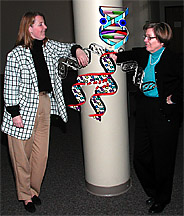Cartoons
created for a college biotechnology course? The image may seem as farfetched
as Fred and Barney at a conference on cold fusion techniques. But before
you draw conclusions, visit the on-line site for “Biotechnology:
Science and Socioeconomic Issues.” What you will find is a animated
film that step-by-step explains genetic engineering—the process by
which scientists cut and paste snippets of DNA from one strand of DNA
to another.

Dr.
Lesa Griffiths, associate dean for academic programs, and Dr. Sherry Kitto,
professor of horticulture at the University of Delaware College of Agriculture
and Natural Resources, developed "Mr. Gene" and the lively,
online lesson as a teaching tool for their course on perspectives on biotechnology.
In addition to examining biotechnology as it relates to the social sciences,
media and consumers, the course curriculum requires a few lessons in biology,
including recombinant DNA technology.
The idea
for a computer animation came from a student who had struggled to learn
the details of the technology.
"When
we handed out a mid-year evaluation on how we could improve the course,
one student suggested that a cartoon on recombinant DNA technology would
make it easier to understand.
"It
sounded like a fun idea and the timing was perfect," says Griffiths.
"The University had just announced the availability of student
technology assistant grants through the PRESENT, UD's teaching,
learning and technology center, so we thought we might be able to get
some support."
Christina
Williams, a senior at the time and now a graduate student in plant molecular
biology at UD, offered to help with the project. Williams says she spent
20 hours a week over Winter Session 2000 working on the project, doing
library research, drawing diagrams and adding text, before meeting with
Kitto and PRESENT staff member Becky Kinney, an animator experienced
at creating educational software.
“It’s
difficult to describe my approach to creating the cartoon-like animation,”
says Kinney.
“I started
with a written script and some static graphics from Christina Williams.
The original idea was that I would create interactive computer animations
showing how each static graphic ‘became’ the next, synching
the action with the narration.”
Griffiths
describes the animation project as a collaborative effort, made possible
with the help of
undergraduate and graduate students and staff at PRESENT and University Media
Services. The voiceover recording by journalism professor Ralph Begleiter
was captured digitally in the ITV studios.
“So
many concepts in science are difficult to teach in a laboratory because
you can’t ‘see’ anything,” says Kitto, “so
narrated computer animation like this really facilitates learning. We
hope this project will be the first in a series.”
The lesson takes about 20
minutes to complete and is available at http://present.smith.udel.edu/biotech/.
